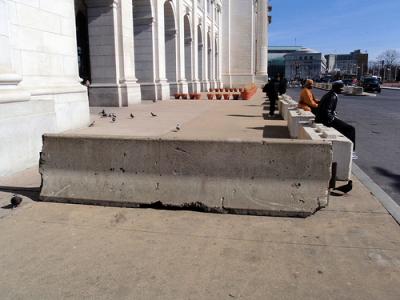
Security Measures Are Degrading the Urban (and Human) Experience

Several times each day, a military helicopter flies over my house in Washington. It flies much closer to the ground than other aircraft, and it's seriously noisy. We don't know why, exactly, since in DC you tend just to accept these things, but it started after September 11. We live in a neighborhood with a lot of embassies, and the Department of Homeland Security's campus is only about a mile away, so those seem the likely factors.
When I walk through some of the embassies on my way to the metro, there are ugly "jersey barriers" (those concrete things in the photo) several feet out into the street to keep cars from getting too close. Police cars are strategically placed, watching. When I get to the office, I have to pass through security gates to get up to NRDC's suite. Our beautiful (and recently LEED-gold-certified) building has two entrances from the street, in theory, but one of them is locked to visitors. Ironically, you can no longer access 1200 New York Avenue from New York Avenue. Go figure.
If I go to visit EPA's smart growth office, as I do with some regularity, I have to walk all the way around their huge building to get to an entrance that visitors can use, identify myself, go through a metal detector, and wait for an escort to come down to the entrance and take me up to the office.
This kind of thing doesn't happen only in Washington, of course. It's pretty much everywhere now, though perhaps especially so here because of the many institutions that are here. In short, one of the ways in which city life isn't what it used to be is that so much of what used to be public is no longer really public. As a result, some of our humanity is lost, to say nothing of efficient travel.
A new project managed from the University of Colorado-Denver has determined that fully 17 percent of ostensibly public space in New York, Los Angeles, and San Francisco - streets, sidewalks, plazas, and the life - is now restricted or closed off to the public altogether. For commentary and more photos, go here, where I have posted a longer article on the subject. But what to do?


Comments
Write your comments in the box below and share on your Facebook!